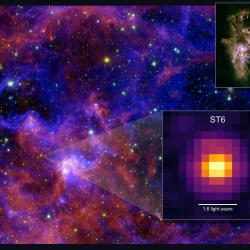Distant “Heavy Metal” Gas Planet is Shaped Like a Football
UMD astronomer contributes to discovery of first known exoplanet hot enough for heavy elements to evaporate and escape its atmosphere
The scorching hot exoplanet WASP-121b may not be shredding any heavy metal guitar riffs, but it is sending heavy metals such as iron and magnesium into space. The distant planet’s atmosphere is so hot that metal is vaporizing and escaping the planet’s gravitational pull. The intense gravity of the planet’s host star has also deformed the sizzling planet into a football shape.
The new observations, made by an international team of astronomers using NASA's Hubble Space Telescope, describe the first known instance of heavy metal gas streaming away from a “hot Jupiter,” which is a nickname for large, gaseous exoplanets that orbit very close to their host stars. A research paper describing the results, co-authored by University of Maryland Astronomy Professor Drake Deming, was published in the August 1, 2019 issue of The Astronomical Journal.
“This planet is a prototype for ultra-hot Jupiters. These planets are so heavily irradiated by their host stars, they’re almost like stars themselves,” Deming said. “The planet is being evaporated by its host star to the point that we can see metal atoms escaping the upper atmosphere where they can interact with the planet’s magnetic field. This presents an opportunity to observe and understand some very interesting physics.”
Normally, hot Jupiter planets are still cool enough inside to condense heavier elements such as magnesium and iron into clouds that remain in the planet’s atmosphere. But that's not the case with WASP-121b, which is orbiting so close to its host star that the planet’s upper atmosphere reaches a blazing 4,600 degrees Fahrenheit. The planet is so close, in fact, that it is being ripped apart by the star's gravity, giving the planet an oblique football shape. The WASP-121 star system resides about 900 light-years from Earth.
"Heavy metals have been seen in other hot Jupiters before, but only in the lower atmosphere," explained lead researcher David Sing of Johns Hopkins University. "With WASP-121b, we see magnesium and iron gas so far away from the planet that they're not gravitationally bound. The heavy metals are escaping partly because the planet is so big and puffy that its gravity is relatively weak. This is a planet being actively stripped of its atmosphere."
The researchers used Hubble's Space Telescope Imaging Spectrograph to search for ultraviolet light signatures of magnesium and iron. These signatures can be observed in starlight filtering through WASP-121b's atmosphere, as the planet passes in front of its host star.
The observations of WASP-121b add to the developing story of how planets lose their primordial atmospheres. When planets form, they gather an atmosphere made of gas from the disk that gave rise to both the planet and its host star. These young atmospheres consist mostly of hydrogen and helium, the most plentiful elements in the universe. As the planet moves closer to its star, much of this early atmosphere burns off and escapes to space.
"The hot Jupiters are mostly made of hydrogen, and Hubble is very sensitive to hydrogen, so we know these planets can lose the gas relatively easily," Sing said. "But in the case of WASP-121b, the hydrogen and helium gas is outflowing, almost like a river, and is dragging these metals with them. It's a very efficient mechanism for mass loss."
According to the researchers, WASP-121b will be a perfect target for NASA's James Webb Space Telescope, scheduled for launch in 2021. The Webb telescope will enable researchers to search for water and carbon dioxide, which can be detected at longer, redder wavelengths of infrared light. The combination of Hubble and Webb observations should give astronomers a more complete inventory of the chemical elements that make up the planet's atmosphere.
“Hot Jupiters this close to their host star are very rare. Ones that are this hot are even rarer still,” Deming added. “Although they’re rare, they really stand out once you’ve found them. We look forward to learning even more about this strange planet.”
###
This press release was adapted from text provided by the Space Telescope Science Institute.
The WASP-121b study is part of the Panchromatic Comparative Exoplanet Treasury (PanCET) survey, a Hubble program to look at 20 exoplanets, ranging in size from several to more than 100 times Earth's mass. The survey is the first large-scale comparative study of distant worlds using observations in ultraviolet, infrared and visible light.
The research paper, “The HST PanCET Program: Exospheric Mg II and Fe II in the Near-UV transmission spectrum of WASP-121b using Jitter Decorrelation,” David Sing, Panayotis Lavvas, Gilda Ballester, Alain Lecavelier des Etangs, Mark Marley, Nikolay Nikolov, Lotfi Ben-Jaffel, Vincent Bourrier, Lars Buchhave, Drake Deming, David Ehrenreich, Thomas Evans, Tiffany Kataria, Nikole Lewis, Mercedes López-Morales, Antonio García Muñoz, Gregory Henry, Jorge Sanz-Forcada, Jessica Spake, and Hannah Wakeford, was published in The Astronomical Journal on August 1, 2019.
This work was supported by NASA (Award No. HST-GO-14767), the European Research Council (Award No. 724427), the German Research Foundation (Award No. GA 2557/1-1), the Spanish Ministry of Economy and Competitiveness (Award No. AYA2016-79425-C3-2-P), the French National Centre for Scientific Research, the French National Institute of Sciences of the Universe, the French National Centre for Space Studies, and the Swiss National Science Foundation. The content of this article does not necessarily reflect the views of these organizations.
Media Relations Contacts: Matthew Wright, 301-405-9267, mewright@umd.edu
University of Maryland
College of Computer, Mathematical, and Natural Sciences
2300 Symons Hall
College Park, MD 20742
www.cmns.umd.edu
@UMDscience
About the College of Computer, Mathematical, and Natural Sciences
The College of Computer, Mathematical, and Natural Sciences at the University of Maryland educates more than 9,000 future scientific leaders in its undergraduate and graduate programs each year. The college's 10 departments and more than a dozen interdisciplinary research centers foster scientific discovery with annual sponsored research funding exceeding $175 million.







